

In order to use a Normal map you need to provide the Denoiser with the Albedo map first. The Normal map is another feature image that can help.

This map tends to help restore texture details. It’s basically just a representation of the texture information within the scene independant of shading (lighting) or viewing angle. The Albedo map is a feature image that provides the largest quality bump to the denoiser. Unfortunately you still can’t expect the AI denoiser to work real magic If there is too much noise you will still get a painted effect.

Some of these issues can be resolved or mitigated by using leMaik’s Denoising Plugin which has the ability to, not only to automatically denoise a scene once the target SPP is reached but, render auxiliary feature images / AOVs (Arbitrary Output Variables) to provide additional information to the denoiser. Below you can see an extreme case where a 32 SPP scene lit mostly by emitters was denoised. Noteworthy visual artifacts are the deformed blocks, blurred textures, and the painted effect you can often see. ExampleĪs some of you may have noticed while AI based denoisers work wonders there are a few issues with the outputted images. A few months later I discovered Intel’s Open Image Denoise an AI based denoiser that works on any CPU with SSE4.1 support. Unfortunately at the time it was limited to just Nvidia GPUs. Using Split Pass would also mean that less effort is required to recombine the completed results.įirst showcased by u/StaysAwakeAllWeek in Nov 2018, this was the first time an AI based denoiser was mentioned on r/Chunky. Further mitigations would be to instead combine this Multi-plane technique with Split Pass to further speed up rendering and retain bounce lighting from Sun/Sky present within the background pass. The key issue with this technique is that the lighting information in the foreground element would not completely match the background. With a careful selection of Chunks and combination of the two elements in post a reasonable result can be achieved. Foreground element should be loaded with a reduced number of chunks, to speed up rendering speed, with the chosen emittance. Meaning lower SPPs could be used for this element. This would lead to zero emitter noise in the distance. By rendering the complete scene with emitters at 0.01, emitters would light up but not emit visible light. llbit’s exampleĪ technique which I never released Covers rendering a scene with a clear and distinct fore and background elements. For an Emitter pass things are a bit more complex: Enable emitters (if not done), disable sunlight, and Sky mode: black OR enable transparent sky. For a Sunlight pass you would simply need to disable emitters. The different lighting passes can be setup through the Lighting and the Sky & Fog tabs. Comparing a typical 400 SPP Sunlight + Raw Emitter image to the Sunlight + Filtered Emitter image it was seen that the lighting was softer and there was less noticeable noise. The noisy emitter pass could then be filtered with a Selective Gaussian Blur in GIMP and then combined. Original examplesĪn approach llbit showcased in September 2015.īy rendering the scene twice, first with a “Sunlight Pass” to 200 SPP and then a “Raw Emitter Pass” to 400 SPP. Increasing the canvas resolution does increase memory consumption. Blurring and scaling to target resolution should result in better results than rendering at native resolution. The noise is still present but given the higher resolution each pixel of noise takes up less screen space compared to the “noiseless” data from the sun/sky. Generally this means that a scene at say 1920x1080 with a target of 1024 SPP could be rendered at 3840x2160 at 256 SPP- These should take the same amount of time to render and the 2160p image would have perceptually less noise than the same scene rendered natively at 1080p. In any case it is assumed you render the scene for the same duration. The basic premise is to render a scene at a higher than target resolution, apply a Gaussian blur to the whole image, and then scale it down to the target resolution.


 0 kommentar(er)
0 kommentar(er)
